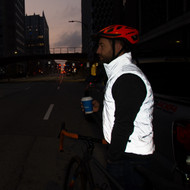Night Riding: Be Seen and Stay Warm
Night Riding: Be Seen and Stay Warm
Daylight Saving Time is right around the corner, and with it comes shorter days. That does not have to end your rides. Night riding can be safe and fun with the right lights, reflective details, and a smart layering plan to stay warm.
Why Visibility Matters
Drivers notice contrast and motion first, so reflective details on moving parts makes you stand out. Ankles, knees, and shoulders are prime spots. A bright front light and a reliable rear light make your line easy to read so everyone shares the road.
Lights 101
Run a steady front light to see the surface and a blinking rear light to be seen. Aim the front beam slightly down so it lights the lane without glare. A second rear light mounted higher, on a helmet or pack, adds movement that stands out. Keep lenses clean, charge after each ride, and stash a tiny backup blinker since cold nights shorten runtime.
Reflective Apparel and Placement
Choose pieces with reflective hits on the chest, shoulders, and lower legs so your motion pops under headlights. A hi-viz jersey or vest helps on busy streets, while subtle reflective piping works quietly on neighborhood roads. Wash prints inside out in cool water, and line dry to keep them bright.
Layering by Temperature
- 50 to 60°F. A light base with a breathable outer is plenty for an easy evening pace. Full-finger gloves and a thin cap under the helmet take the edge off.
- 40 to 50°F. A thermal base with a wind-blocking outer smooths out the chill once the sun is gone. If you run cold, add a thin mid layer; slightly warmer gloves and toe covers help.
- Below 40°F. A thermal base with an insulated outer keeps the core warm. Add a neck gaiter, winter gloves, and full shoe covers so small details do not cut the ride short.
Routes That Feel Good at Night
City streets settle into a quieter rhythm after dark. Storefront windows throw soft reflections, lights cycle, and the line ahead is easy to follow under a steady beam. Familiar roads feel calmer, with just enough glow from streetlights to keep the pace relaxed.
Trails at night trade traffic noise for a tunnel of light. The world narrows to your headlamp and the surface speaks in small textures: gravel that crunches, packed dirt that hums, leaves that flicker and are gone.
Rail trails and park loops feel steady and predictable after hours, with gentle grades that let you settle in. In a small group the lights stack and the path seems to float; solo, it is quiet and steady, just you and the trail.
Bike Setup for the Dark
A clean drivetrain makes the whole ride feel smoother, and fresh tread grips cold pavement with fewer surprises. Lights mounted securely do not rattle, and a quick wipe of the lenses after damp rides keeps the beam crisp. Reflective sidewalls or a few spoke reflectors add side-to-side visibility that looks great rolling by.
Night Ride Checklist
- Front light and rear light (plus a tiny backup)
- Reflective details on bike and kit
- Gloves to keep hands warm on brisk nights
- ID, phone, small multitool, and a packable shell just in case

